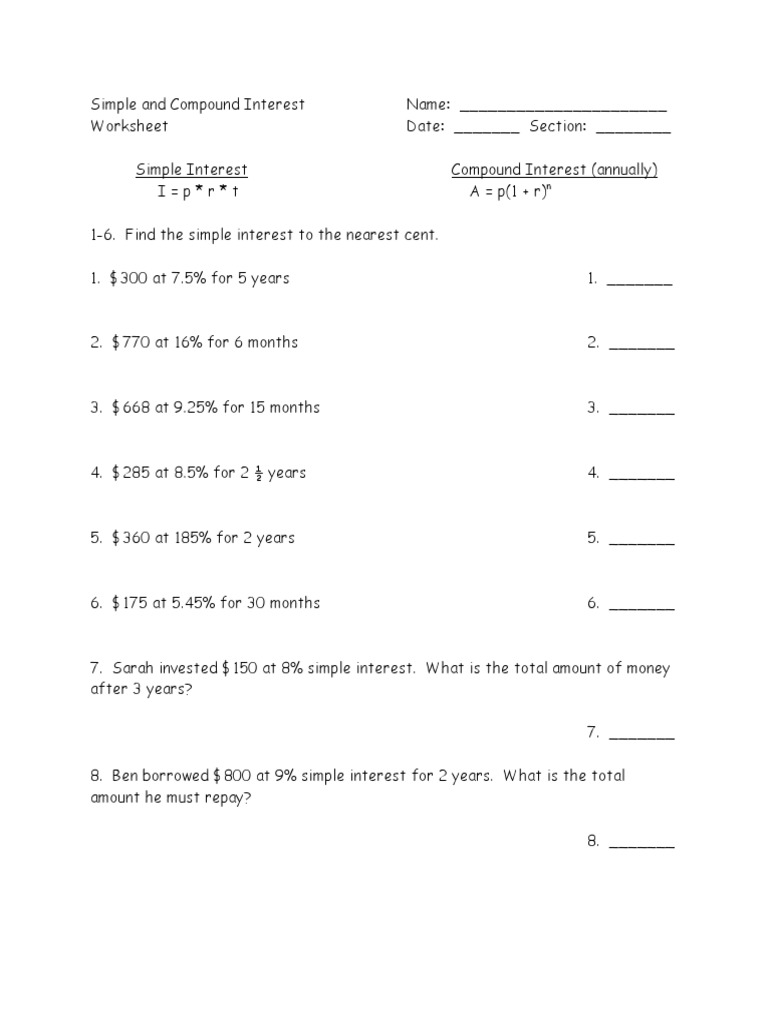Mastering Compounded Interest Word Problems: Quick Tips & Tricks

Compounded interest word problems can seem daunting, but with the right strategies, they become manageable and even straightforward. Whether you’re a student preparing for exams or an investor planning for the future, understanding how to tackle these problems is crucial. In this guide, we’ll break down compounded interest word problems into digestible steps, offering quick tips and tricks to master them. From identifying key components to applying formulas efficiently, you’ll gain the confidence to solve any problem that comes your way.
Understanding the Basics of Compounded Interest

Before diving into word problems, it’s essential to grasp the concept of compounded interest. This is the interest calculated on the initial principal and also on the accumulated interest of previous periods. The formula for compounded interest is:
A = P(1 + r/n)^(nt)
Where:
- A = the amount of money accumulated after n years, including interest.
- P = the principal amount (the initial amount of money).
- r = annual interest rate (decimal).
- n = number of times interest is compounded per year.
- t = time the money is invested for, in years.
💡 Note: Always convert percentages to decimals when using the formula.
Breaking Down Compounded Interest Word Problems

Word problems often hide the necessary variables in sentences. Here’s how to extract them:
- Identify the Principal (P): Look for terms like “initial investment,” “starting amount,” or “original sum.”
- Find the Interest Rate ®: Phrases like “annual interest rate” or “percentage per year” indicate this value.
- Determine the Compounding Frequency (n): Check for “compounded annually,” “quarterly,” or “monthly.”
- Locate the Time Period (t): Words like “years,” “months,” or “periods” signal this variable.
| Term in Problem | Variable |
|---|---|
| Initial deposit | P |
| 5% annual interest | r = 0.05 |
| Compounded quarterly | n = 4 |
| For 3 years | t = 3 |

Step-by-Step Problem Solving

Once you’ve identified the variables, follow these steps:
- Plug the Values into the Formula: Substitute P, r, n, and t into the compounded interest formula.
- Calculate the Result: Use a calculator to solve for A, ensuring you follow the order of operations.
- Interpret the Answer: Determine what the problem is asking for (e.g., final amount, interest earned) and provide the solution.
📌 Note: Double-check your units (e.g., years, percentage) to avoid errors.
Quick Tips & Tricks for Efficiency

- Use a Calculator: Avoid manual calculations for complex problems to save time and reduce errors.
- Practice Regularly: The more problems you solve, the faster you’ll identify patterns.
- Memorize the Formula: Having the formula readily available in your memory speeds up problem-solving.
- Break Down Problems: If a problem seems overwhelming, tackle it in smaller steps.
Checklist for Solving Compounded Interest Word Problems

- [ ] Identify the principal (P).
- [ ] Determine the annual interest rate ® and convert it to a decimal.
- [ ] Find the compounding frequency (n).
- [ ] Locate the time period (t).
- [ ] Substitute values into the formula and calculate.
- [ ] Interpret the result based on the problem’s question.
By following these steps and tips, you’ll be well-equipped to handle compounded interest word problems with ease. Practice makes perfect, so keep refining your skills to become a master problem solver.
What is compounded interest?
+Compounded interest is interest calculated on the initial principal and the accumulated interest from previous periods.
How do I identify variables in a word problem?
+Look for keywords like "initial amount," "interest rate," "compounded," and "time period" to identify P, r, n, and t.
Can I solve compounded interest problems without a calculator?
+While possible, using a calculator is recommended for accuracy and efficiency, especially for complex problems.
Mastering compounded interest word problems is a valuable skill for both academic and real-world applications. With a clear understanding of the formula, practice, and strategic problem-solving, you’ll tackle these challenges confidently. Keep learning, and soon you’ll be solving problems like a pro! (compounded interest calculator,financial planning,investment strategies)


